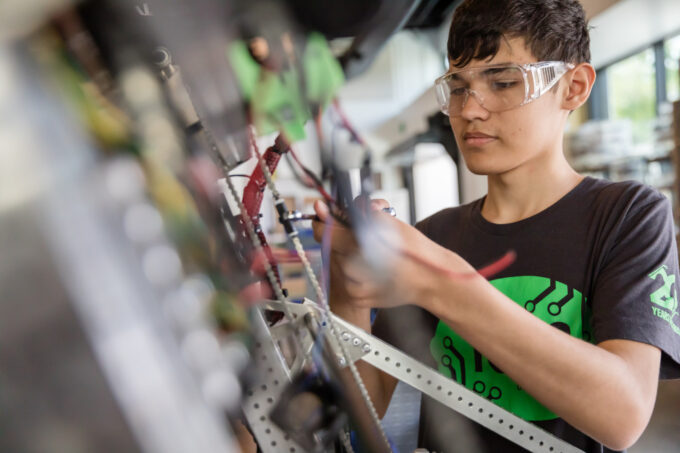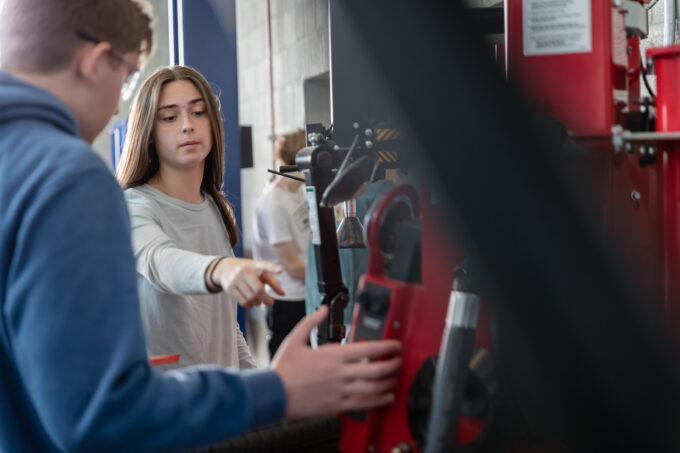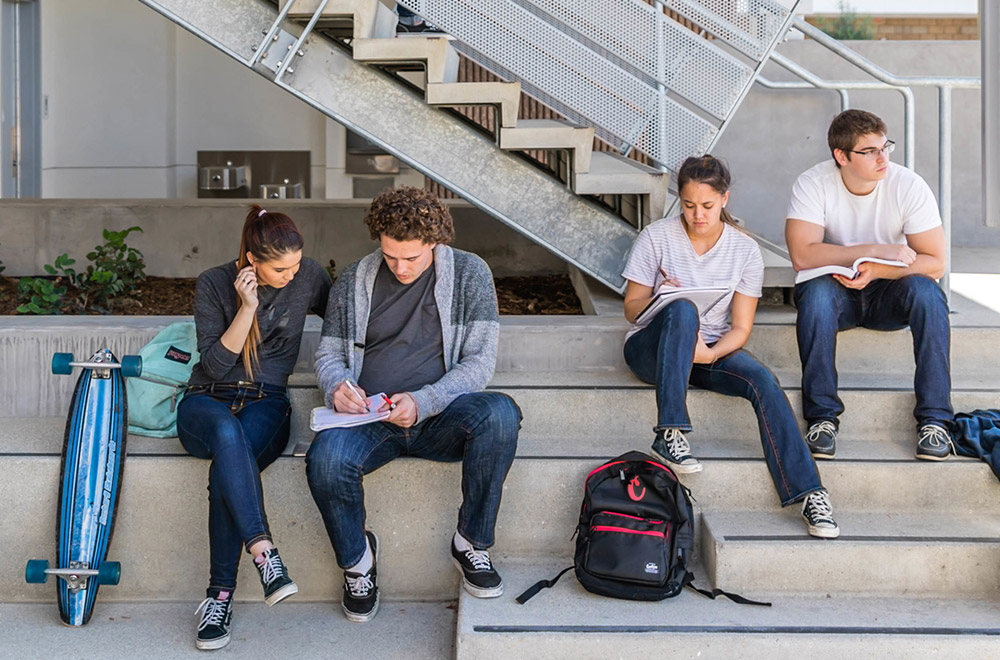Citrus Circuits is the name of the robotics club here at Davis Senior High School (DSHS), just west of Sacramento in California’s Central Valley. This group of 120 students enjoys strong community and school support and has won many regional robotics competitions. They regularly compete against teams from around California and as far away as Shanghai, Taipei, and Hawaii. Club members turned out enthusiastically last year in their black logo shirts for the dedication of their new home on campus, a 7,800 SF building designed by HMC Architects.
The building serves engineering and robotics students, one of 15 CTE Pathways at DSHS. It features a manufacturing shop with big CNC machines for automated manufacturing. A large vaulted main robotics lab space is the hub of the program and serves as a practice space for robotics competitions, which have become very popular in recent years. These events feature all the excitement in athletics, with spectators and teams competing against each other to complete tasks or specific maneuvers in autonomous and remote-controlled modes. Referees score these matches in real-time, and there are trophies to be won.
The building is a simple modernist design with a gracefully slanted roof—we referenced design elements from the All Student Center building and other existing design elements on campus. There were unique programmatic requirements. Some of the machines needed water and lots of power, dust collection systems, ventilation, wireless communication, and low-voltage power. The oversized garage doors accommodate the equipment and materials necessary for student projects, including plywood, large metal sheets, and tubes. We also included space for the program to grow in future years. The CTE staff worked extensively with counterparts at UC Davis in the machines’ planning, technical design, and specification.
This beautiful facility is all the sweeter, given that the club was initially started as an informal afterschool club in a shipping container where they’d run extension cords across the parking lot to power the equipment. The program has moved through various temporary facilities over the past twenty years. Steve Harvey, a math teacher at Da Vinci Charter Academy in Davis, was the driving force behind the formation of Citrus Circuits. The building is named after him.

In the Farming Heartland, a Program Aligned with the AG Economy
Across campus and seemingly worlds away from robotics are the Agriculture and Animal Science CTE facilities, a cluster of buildings that includes a barn, classroom, greenhouse, poultry house, and show ring. The upgrades there included a lot of small things that added up to a wholly revamped facility: new lab tables in the classrooms, more welding stations, a new slab in the barn for better cleaning and drainage, a cooling system necessary for pigs, chickens, turkeys, goats, and sheep, a covered area for cleaning the animals, and an area of planter boxes. This was where we stretched and got a lot out of our budget.
Agriculture goes to the core of the economy and ethos of Davis, a college town in the middle of the Central Valley farming heartland. Around 92 percent of Yolo County is designated for agriculture and open space preservation, making agriculture the critical industry in the area. Agricultural technology and plant and seed bio-engineering advances drive the local economy and workforce needs. Agriculture enhancements and biotech development are key focus areas for growth in the region. With this DSHS modernization, the Agriculture and Natural Sciences pathways will reach more than 576 students.
The DSHS Ag pathway will ultimately help serve local workforce needs and prepare students for high-demand, well-paying careers as agronomists, viticulturists, plant breeders, geneticists, greenhouse managers/ technicians, lab technicians, vet techs, Ag engineers, welders, machinists, technicians, and more. Their motto, “Plant it, grow it, raise it, and service it, all right here in Yolo County,” speaks to the local focus. The DSHS Ag pathways are associated with the Future Farmers of America (FFA), a national organization founded in 1928 to promote agriculture education. It has nearly one million members in all 50 states. At the ribbon cutting, it was cool to see all the students in their FFA jackets, some of whom proudly held chickens.
Veterinary and animal sciences, like all of our other pathways, provides real-world experience for our students, so this is an opportunity for them to work with industry professionals and animals on-site.– Kathryn Myler, Vice President of Davis Future Farmers of America

Not Your Grandfather’s Auto Shop—Preparing for the EV Future
A nondescript building featuring three automotive bays is not far from the animal corrals. This is the home of the transportation CTE pathway, where upgrades included the addition of a service bay, an exterior canopy, enhancements for pneumatic tools, car lifts, air and power, technology additions, and new restrooms. This modest-looking structure is not your grandfather’s auto shop. Inside, students learn how to repair and assemble EVs: battery, motor, steering, suspension, and all internal systems. They use Switch Cars, which look like large go-carts, to practice honing these skills—skills that will be in great demand given the emerging EV market in the US. By 2030, electric vehicle sales are projected to reach 40 percent of new car sales and 50 percent by 2035 (Goldman Sachs Research).
Rapid advances in automotive technology are creating a new car culture in California that is tuned to the environmental impacts of vehicle emissions and focused on more sustainable ways to fuel mobility. DSHS’s aging transportation facilities date back to the 1970s, when students learned about gas-guzzler cars with internal combustion engines.
Revamped facilities have nearly doubled the amount of work bays available to students, provided safe and accessible workspaces, and, importantly, will ensure students have access to the technology needed to gain industry-recognized credentials to begin careers with the many Davis-area transportation industry partners at the forefront of greener modes of mobility. Davis is at the center of international efforts to research and build more sustainable plug-in vehicles, with UC Davis’s Plug-in Hybrid & Electric Vehicle Research Center and its Hyundai Center of Excellence in Vehicle Dynamic Systems leading the way.
I think these three projects struck a nice balance of being able to support growth and innovation for long-standing successful CTE programs.– Tyler Millsap, Administrative Lead for CTE at DJUSD

Made Possible by Key State CTE Grants
The CTE upgrades at DSHS were made possible by funds from local Measure M and State of California CTE grants totaling $6.2 million. Tyler Millsap is the administrative lead for the CTE programs at Davis Joint Unified School District. He has been with the district as a teacher and in various roles for 18 years.
He explains the investment in these facilities: “I think these three projects struck a nice balance of supporting growth and innovation for long-standing, successful CTE programs. The robotics got a bigger piece than the others with the new building. But you have to understand that the program has a strong following and a track record of great success. So I think the budget we had to work with came out to a nice balance of benefiting as many programs as it could.”
From the feedback we are receiving, these three projects at DSHS drive engagement and enthusiasm and provide students with excellent opportunities for specialized, hands-on learning in career fields directly relevant to the Ag and high-tech economy in Davis.
I didn’t expect to like it that much, but the second I got here, it was like, this is fun. I want to keep going, and this was mainly the class I looked forward to the rest of the day. I learned about something in a male-dominant field and enjoyed myself. – Charm Blackwell, Student

